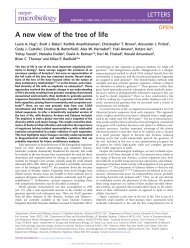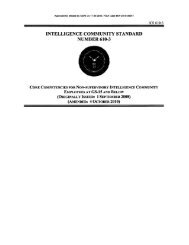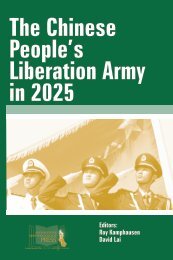The Joint Force in a Contested and Disordered World
JCS-JOE-2035
JCS-JOE-2035
You also want an ePaper? Increase the reach of your titles
YUMPU automatically turns print PDFs into web optimized ePapers that Google loves.
harm <strong>and</strong> outcomes between the concepts of war <strong>and</strong> peace—with important consequences<br />
for national <strong>and</strong> <strong>in</strong>ternational security…” 34<br />
With<strong>in</strong> this context, conflict <strong>and</strong> war are likely to occur as states struggle to def<strong>in</strong>e <strong>and</strong> credibly<br />
protect sovereignty <strong>in</strong> cyberspace. Def<strong>in</strong><strong>in</strong>g the boundaries that exist between sovereign <strong>and</strong> nonsovereign<br />
areas has always been difficult, contentious, <strong>and</strong> usually resolved through war. In each<br />
of the terrestrial doma<strong>in</strong>s (l<strong>and</strong>, sea, <strong>and</strong> air), the del<strong>in</strong>eation of boundaries, rights, <strong>and</strong><br />
responsibilities took time to fully establish, was (<strong>and</strong> cont<strong>in</strong>ues to be) contested, <strong>and</strong> eventually<br />
required the creation of basic <strong>and</strong> mutually acceptable rules <strong>and</strong> norms govern<strong>in</strong>g their use. <strong>The</strong><br />
Treaty of Westphalia, which def<strong>in</strong>ed the modern notion of the nation-state <strong>and</strong> “national<br />
sovereignty,” was explicitly designed to lower the risk of violence <strong>and</strong> war. Ultimately, it took<br />
violence out of the h<strong>and</strong>s of <strong>in</strong>dividuals, privateers, militias, <strong>and</strong> mercenaries, <strong>and</strong> imposed<br />
reciprocal responsibilities on states to recognize one another’s borders <strong>and</strong> <strong>in</strong>ternal autonomy.<br />
Rules <strong>and</strong> norms are poorly established <strong>in</strong> cyberspace. Thus, the same dynamic of states def<strong>in</strong><strong>in</strong>g<br />
<strong>and</strong> defend<strong>in</strong>g sovereignty <strong>in</strong> cyberspace is likely to play out over the next several decades<br />
Although frequently referred to as part of the global commons, few Americans believe that<br />
government <strong>and</strong> DoD systems, corporate networks, or personal bank<strong>in</strong>g <strong>and</strong> f<strong>in</strong>ancial accounts are<br />
“owned by none, accessible to all” accord<strong>in</strong>g to the classic def<strong>in</strong>ition of what constitutes a<br />
commons. 35 <strong>The</strong> reflex to th<strong>in</strong>k of cyberspace as a commons is perhaps reflective of the design<br />
philosophy underp<strong>in</strong>n<strong>in</strong>g the Internet which is based on shared st<strong>and</strong>ards, an open exchange of<br />
<strong>in</strong>formation, <strong>and</strong> accessibility.<br />
Today, the cyber doma<strong>in</strong> is so <strong>in</strong>tegral to the basic <strong>in</strong>frastructure of the United States <strong>and</strong> the larger<br />
global economy that actions to deny, degrade, or destroy parts of it have the potential to create<br />
<strong>in</strong>tolerable security problems. <strong>The</strong> contest <strong>in</strong> cyberspace will cont<strong>in</strong>ue to be fraught with<br />
misperception <strong>and</strong> miscommunication, particularly with regard to the proportionality of damage<br />
caused by cyber-attacks <strong>and</strong> equivalent consequences <strong>in</strong> the other doma<strong>in</strong>s. By 2035, <strong>in</strong>ternational<br />
norms might be created <strong>and</strong> adopted that def<strong>in</strong>e what is sovereign versus what is common <strong>in</strong><br />
cyberspace. As a result, a range of cyber activities will be <strong>in</strong>creas<strong>in</strong>gly <strong>and</strong> more comprehensively<br />
l<strong>in</strong>ked with national security strategies.<br />
Nature of Potential Adversaries<br />
<strong>The</strong> United States <strong>and</strong> other states will certa<strong>in</strong>ly wish to survive <strong>and</strong> thrive <strong>in</strong> cyberspace.<br />
However, <strong>in</strong> an environment where the difference between national <strong>and</strong> “common” cyberspace is<br />
ill-def<strong>in</strong>ed, there will be a greater degree of ambiguity, friction, conflict, <strong>and</strong> war with a wide range<br />
of cyber-capable actors. Not all states will take the same approach to cyberspace control. However,<br />
many competitor states, react<strong>in</strong>g to the growth of the <strong>in</strong>formation-rich <strong>and</strong> uncontrolled global<br />
Internet, will cont<strong>in</strong>ue to develop cyber-security organizations <strong>and</strong> <strong>in</strong>stall barriers such as Ch<strong>in</strong>a’s<br />
“Great Firewall” to protect their critical cyber <strong>in</strong>frastructure, monitor domestic opponents, <strong>and</strong><br />
control the flow of <strong>in</strong>formation with<strong>in</strong> their borders.<br />
In many places, the next few decades will see the development of cyberspace with more<br />
authoritarian characteristics focused on limit<strong>in</strong>g access, connections, <strong>and</strong> compatibility with the<br />
34<br />
Lucas Kello, “<strong>The</strong> Mean<strong>in</strong>g of the Cyber Revolution,” International Security, (2012).<br />
35<br />
See “Context 4: Disrupted Global Commons” above.<br />
34











